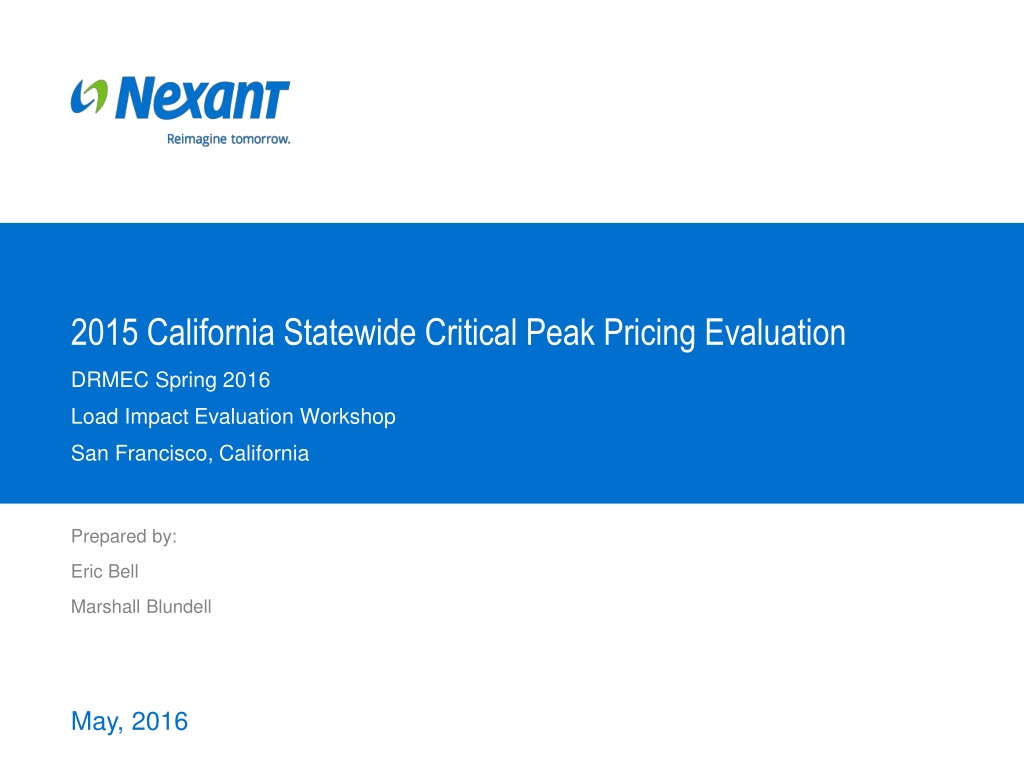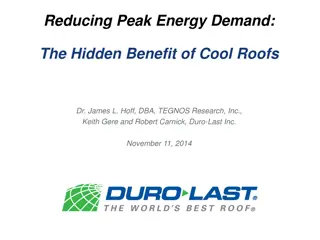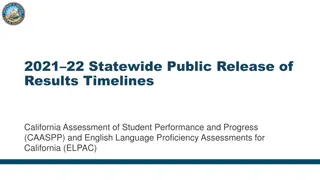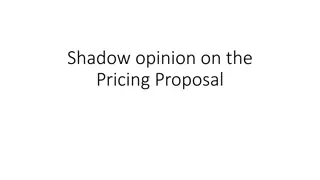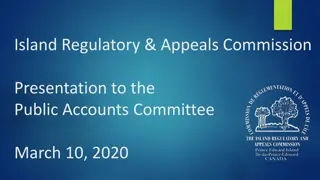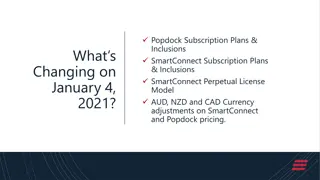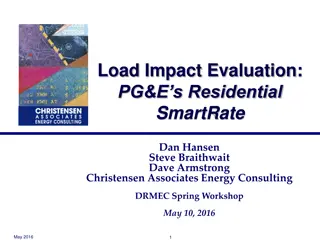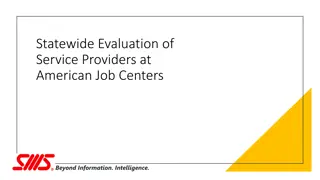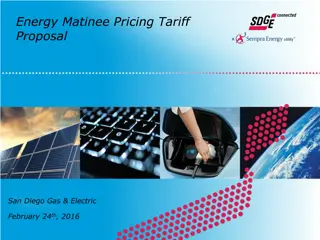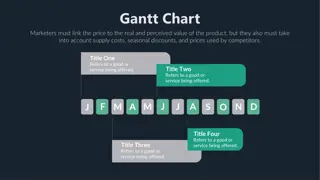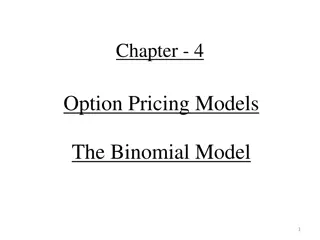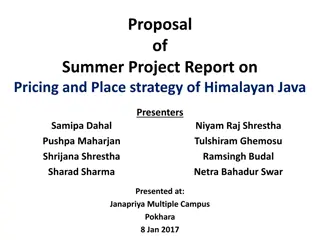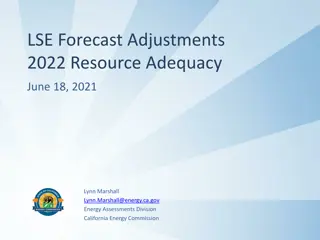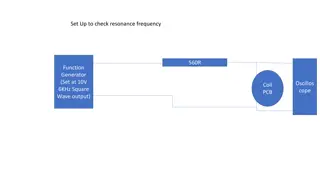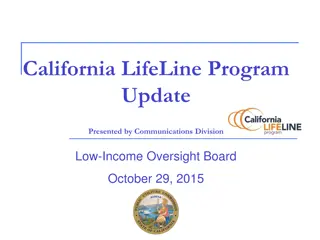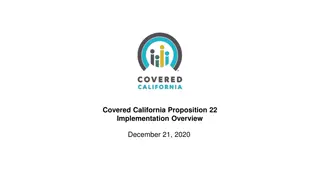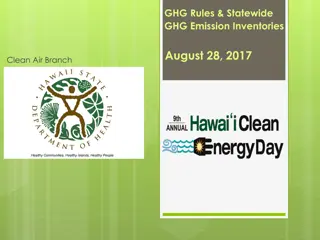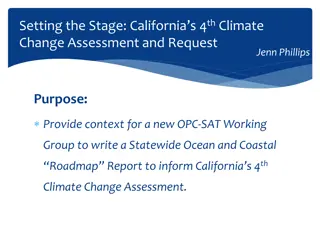Evaluation of 2015 California Statewide Critical Peak Pricing Program
The evaluation of the 2015 California Statewide Critical Peak Pricing (CPP) program assesses the impact of higher electricity rates during peak hours on selected days, aiming to reduce demand and infrastructure costs. The program default rate for large customers like PG&E, with SMB customers gradually transitioning to CPP. Detailed analysis of hours of availability and actual usage across utilities provides insights for future implementation.
Download Presentation

Please find below an Image/Link to download the presentation.
The content on the website is provided AS IS for your information and personal use only. It may not be sold, licensed, or shared on other websites without obtaining consent from the author. Download presentation by click this link. If you encounter any issues during the download, it is possible that the publisher has removed the file from their server.
E N D
Presentation Transcript
2015 California Statewide Critical Peak Pricing Evaluation DRMEC Spring 2016 Load Impact Evaluation Workshop San Francisco, California Prepared by: Eric Bell Marshall Blundell May, 2016
Program Description Critical Peak Pricing (CPP) is an electric rate in which a utility charges a higher price for consumption of electricity during peak hours on selected days, referred to as critical peak days or event days Typically, CPP hours coincide with the utility s peak demand SDG&E s events last from 11 AM to 6 PM while PG&E s and SCE s last from 2 to 6 PM The higher price during peak hours on critical event days is designed to encourage reductions in demand and reflects the fact that electric demand during those hours drives a substantial portion of electric infrastructure costs Each utility typically calls event days 5 to 15 times a year based on their system conditions when demand is high and supply is short System load patterns across utilities are not always coincidental, particularly between Northern and Southern California Comparisons of impacts between the utilities should be made with caution September 9 and September 10 events were common to all utilities 2
Program Description CPP is the default rate for large customers, and is offered to small and medium customers on a voluntary basis PG&E began defaulting small and medium business (SMB) customers onto CPP in 2014 defaulting will continue in large batches each November through 2016 SDG&E will begin to default their SMB customers onto CPP in 2016, and SCE will begin to default their SMB customers onto CPP starting in 2018 CPP enrollment1 by utility and customer size Large >200 kW Medium 20 kW to 199 kW Small <20 kW Utility PG&E 1,835 23,541 136,843 SCE 2,587 529 532 SDG&E 826 358 23 Hours of Availability and Actual Use No. of Available Dispatches 15 Hours of Availability Hours of Actual Use No. of Actual Dispatches Utility PG&E 60 60 15 SCE 60 48 15 12 SDG&E 126 35 18 5 3 1 Enrollment from average event day in 2015.
Hours of Availability and Actual Use Hours of Availability 60 Hours of Actual Use 60 No. of Available Dispatches 15 No. of Actual Dispatches 15 Utility PG&E SCE 60 48 15 12 SDG&E 126 35 18 5 4
Methodology for large default customers consistent across utilities Large C&I Customers: Used matched control groups with difference-in-differences panel regressions Yields unbiased results for average event Matches evaluated using out-of-sample testing Load impacts for customers that are large or idiosyncratic for which matching was not successful were estimated using individual customer regressions (very few) Default SMB Customers (PG&E only) Methodology same as above but all customers successfully matched Homogeneous population and availability of large control group facilitated finding similar control group counterparts for all customers SCE and SDG&E do not yet have default SMB customers 6
PG&E Ex Post Results Large C&I Customers 7
PG&Es average load reduction for large C&I customers was 5.3%, or 30 MW across the 15 event days in June-September 2015 8
Event Summary PDP was called for 15 events in 2015, compared to 10 in 2014 Most events were clustered into groups of sequential event days Significant differences between 2014 and 2015 2014: 7 out of the 10 events were in July 2015: events were distributed more evenly from June through September PG&E PDP 2015- Large Default Customers Average Hourly Load per Customer- by Event Avg. Customer Load w/ DR Impact Avg. Customer Reference Load Avg. Event Temp. 300 284 284 278 276 272 272 266 264 264 263 263 12.7 14.4 258 256 Avg. Event Hour Cust. Load (kW) 11.0 15.8 8.5 250 248 12.5 9.4 17.3 19.0 16.9 250 23.6 11.1 18.2 13.3 9.8 200 150 271 269 265 264 262 259 255 249 246 245 245 240 239 239 237 100 96.1 94.6 93.9 93.5 93.1 93.0 92.8 92.3 91.3 91.2 88.5 88.2 87.9 87.7 86.9 50 0 9 Event Date
2014 vs 2015 Comparison: Persistent Customers Year over year impacts similar for persistent customers in first 9 events of 2015 Later season events show smaller impacts, significantly lowering the average event impact 2015 impacts: 29.8 MW, 14.24 kW per customer (5.3%) Persistent Customers (1,500 Accounts): 27.6 MW, 18.4 kW per customer (7%) Non-Persistent Customers (593 Accounts): 2.2 MW, 3.7 kW per customer (1.6%) 2014 impacts: 41 MW, 23.2 kW per customer (8.1%) 2014 Impacts (Events 1-10) 2014 Average Impact (Events 1-10) 2015 Impacts (Events 1-9) 2015 Average Impact (Events 1-9) 2015 Impacts (Events 10-15) 2015 Average Impact (Events 10-15) 35 95 30 90 Average Impact per Customer (kW) 25 23.2 kW 22.4 kW 85 20 80 Temperature 14.9 kW 15 75 10 70 5 65 0 60 1 2 3 4 5 6 7 8 9 10 1 2 3 4 5 6 7 8 9 10 11 12 13 14 15 Jun Jul Sep Jun Jul Aug Sep 10 Event Number by Year 2014 2015
PG&E detailed event load impacts- Large C&I Avg. Avg. Customer Reference Load (kW) 248.4 256.2 250.3 266.0 262.7 264.3 262.7 258.3 277.5 264.3 272.3 275.9 283.9 283.6 271.7 266.5 277.3 248.9 Customer Load w/ DR (kW) 238.6 245.0 237.0 248.6 239.1 245.3 245.8 240.1 261.7 254.9 263.8 264.9 271.3 269.2 259.2 252.2 263.4 232.7 Aggregate Impact % Avg. Event Temp. Daily Max. Temp. Impact Reduction Event Date Day of Week Accounts (kW) 9.8 11.1 13.3 17.3 23.6 19.0 16.9 18.2 15.8 9.4 8.5 11.0 12.7 14.4 12.5 14.2 13.9 16.1 (MW) 20.7 23.4 27.9 36.5 49.7 39.8 35.3 38.0 33.1 19.6 17.7 23.0 26.4 30.0 26.1 29.8 34.0 29.0 (%) 3.9% 4.4% 5.3% 6.5% 9.0% 7.2% 6.4% 7.0% 5.7% 3.6% 3.1% 4.0% 4.5% 5.1% 4.6% 5.3% 5.0% 6.5% ( F) 88.2 91.3 88.5 93.9 87.9 93.1 92.3 87.7 93.0 86.9 92.8 93.5 96.1 94.6 91.2 91.4 94.8 94.0 ( F) 101.8 105.0 107.0 106.5 102.0 102.0 107.5 103.0 108.0 104.0 103.5 106.0 104.0 105.0 101.0 103.7 105.0 106.5 6/12/2015 6/25/2015 6/26/2015 6/30/2015 7/1/2015 7/28/2015 7/29/2015 7/30/2015 8/17/2015 8/18/2015 8/27/2015 8/28/2015 9/9/2015 9/10/2015 9/11/2015 Fri Thu Fri Tue Wed Tue Wed Thu Mon Tue Thu Fri Wed Thu Fri 2,107 2,103 2,105 2,106 2,106 2,091 2,092 2,091 2,089 2,089 2,083 2,082 2,083 2,084 2,084 2,093 2,084 2,106 Avg. Event Utility System Peak Hr. Statewide System Peak Hr. Utility system peak hour: 34 MW (June 30, HE18) Statewide system peak hour: 29 MW (September 10, HE17) Average event hour: 29.8 MW 11 Average event temperature shown for event hours 2-6 PM and for single hour for utility and system peak hour.
PG&E Ex Post Results SMB Customers 12
PG&Es average load reduction for SMB customers was 0.8%, or 5.8 MW across the 15 event days in June-September 2015 13
PG&E detailed event load impacts- SMB Customers Avg. Avg. Customer Reference Load Aggregate Impact Avg. Event Temp. Daily Max. Temp. Customer Load w/ DR Impact % Reduction Event Date Day of Week Accounts (kW) 4.7 5.0 4.8 5.2 5.0 5.1 5.2 5.0 5.2 5.0 5.3 5.3 5.5 5.5 5.1 5.1 5.4 4.7 (kW) 4.8 5.1 4.9 5.2 4.9 5.1 5.2 4.9 5.2 5.0 5.2 5.2 5.3 5.3 5.0 5.1 5.3 4.7 (kW) 0.0 0.0 -0.1 0.0 0.0 0.0 0.0 0.1 0.0 0.0 0.1 0.1 0.2 0.1 0.1 0.0 0.1 0.0 (MW) -7.4 -4.7 -9.7 0.5 6.2 6.8 -7.2 7.9 1.4 -1.7 13.7 15.2 26.5 19.5 18.6 5.8 -0.9 20.2 (%) -1.0% -0.6% -1.3% 0.1% 0.8% 0.9% -0.9% 1.1% 0.2% -0.2% 1.8% 2.0% 3.3% 2.4% 2.5% 0.8% 2.5% -0.1% ( F) 90.1 92.5 90.1 95.4 89.3 94.4 94.1 89.2 94.4 87.5 93.5 94.0 96.9 95.7 92.2 92.6 96.0 95.7 ( F) 90.8 92.9 90.8 96.0 89.7 94.9 94.6 89.8 95.2 88.1 94.5 95.6 97.6 96.2 93.2 93.2 96.2 96.0 6/12/2015 6/25/2015 6/26/2015 6/30/2015 7/1/2015 7/28/2015 7/29/2015 7/30/2015 8/17/2015 8/18/2015 8/27/2015 8/28/2015 9/9/2015 9/10/2015 9/11/2015 Fri Thu Fri Tue Wed Tue Wed Thu Mon Tue Thu Fri Wed Thu Fri 152,399 150,899 150,817 150,687 150,540 148,998 148,921 148,851 147,883 147,812 147,436 147,358 146,489 146,373 146,280 148,782 146,373 150,687 Avg. Event Utility System Peak Hr. Statewide System Peak Hr. Utility system peak hour: -0.9 MW (June 30, HE18) Statewide system peak hour: 20.2 MW (September 10, HE17) Average event hour: 5.8 MW 14 Average event temperature shown for event hours 2-6 PM and for single hour for utility and system peak hour
PG&E Ex Post Results All Customers 15
PG&E detailed event load impacts- All Customers Avg. Avg. Customer Reference Load Aggregate Impact Avg. Event Temp. Daily Max. Temp. Customer Load w/ DR Impact % Reduction Event Date Day of Week Accounts (kW) 7.8 8.2 8.0 8.6 8.3 8.4 8.5 8.3 8.8 8.3 8.7 8.8 9.1 9.1 8.6 8.5 9.0 7.8 (kW) 7.7 8.1 7.8 8.3 7.9 8.1 8.3 8.0 8.5 8.2 8.5 8.5 8.8 8.8 8.3 8.3 8.7 7.6 (kW) 0.1 0.1 0.1 0.3 0.4 0.3 0.2 0.3 0.2 0.1 0.2 0.3 0.4 0.3 0.3 0.2 0.3 0.2 (MW) 16.3 22.8 21.3 41.7 59.3 49.9 31.0 49.3 37.5 20.6 34.0 40.9 56.1 52.4 46.9 38.7 36.8 51.9 (%) 1.3% 1.7% 1.6% 3.0% 4.4% 3.6% 2.2% 3.7% 2.6% 1.5% 2.4% 2.9% 3.8% 3.6% 3.4% 2.8% 3.6% 2.9% ( F) 89.9 92.2 89.9 95.2 89.1 94.3 93.9 89.0 94.2 87.2 93.3 93.9 96.8 95.5 92.1 92.4 95.8 95.5 ( F) 101.8 105.0 107.0 106.5 102.0 102.0 107.5 103.0 108.0 104.0 103.5 106.0 104.0 105.0 101.0 103.7 105.0 106.5 6/12/2015 6/25/2015 6/26/2015 6/30/2015 7/1/2015 7/28/2015 7/29/2015 7/30/2015 8/17/2015 8/18/2015 8/27/2015 8/28/2015 9/9/2015 9/10/2015 9/11/2015 Fri Thu Fri Tue Wed Tue Wed Thu Mon Tue Thu Fri Wed Thu Fri 165,800 164,244 164,161 164,028 163,884 162,426 162,349 162,282 161,351 161,278 160,926 160,860 160,032 159,918 159,829 162,224 159,918 164,028 Avg. Event Utility System Peak Hr. Statewide System Peak Hr. Utility system peak hour: 36.8 MW (June 30, HE18) Statewide system peak hour: 51.9 MW (September 10, HE17) Average event hour: 38.7 MW 16 Average event temperature shown for event hours 2-6 PM and for single hour for utility and system peak hour.
SCE Ex Post Results Large C&I Customers 17
SCEs average load reduction was 5.0%, or 29 MW across the 12 event days in July-September 2015 18
SCE detailed event load impacts- Large C&I Avg. Avg. Customer Reference Load Aggregate Impact Avg. Event Temp. Daily Max. Temp. Customer Load w/ DR Impact % Reduction Event Date Day of Week Accounts (kW) 208.8 202.5 208.8 212.8 214.6 212.2 216.2 219.9 216.4 236.5 240.0 218.2 217.2 - 233.0 (kW) 195.4 194.1 199.2 204.6 200.7 198.6 205.7 209.6 206.3 223.2 230.7 208.7 206.4 - 224.2 (kW) 13.5 8.4 9.5 8.2 13.9 13.6 10.5 10.3 10.1 13.3 9.3 9.5 10.8 - 8.8 (MW) 36.3 22.7 25.5 21.8 37.0 36.4 28.0 27.4 26.8 35.6 25.0 25.4 29.0 - 23.6 (%) 6.5% 4.2% 4.6% 3.8% 6.5% 6.4% 4.8% 4.7% 4.7% 5.6% 3.9% 4.3% 5.0% - 3.8% ( F) 82.8 84.8 85.3 85.8 85.0 83.3 94.7 85.1 83.7 93.0 93.4 80.7 86.5 - 93.6 ( F) 98.4 100.1 97.0 104.5 93.1 91.2 102.9 105.4 100.4 102.5 102.0 99.9 98.1 - 102.0 7/1/2015 7/2/2015 7/28/2015 7/29/2015 8/3/2015 8/6/2015 8/14/2015 8/17/2015 8/18/2015 9/9/2015 9/10/2015 9/21/2015 Wed. Thu. Tue. Wed. Mon. Thu. Fri. Mon. Tue. Wed. Thu. Mon. 2,690 2,692 2,679 2,676 2,667 2,667 2,669 2,669 2,667 2,684 2,684 2,682 2,677 - 2,684 Avg. Event Utility System Peak Hr. Statewide System Peak Hr. Utility system peak hour: 0 MW (No event called) Statewide system peak hour: 23.6 MW (September 10, HE17) Average event hour: 29 MW 19 Average event temperature shown for event hours 2-6 PM and for single hour for utility and system peak hour.
SDG&E Ex Post Results Large C&I Customers 20
SDG&Es average load reduction was 8.3%, or 25 MW across the 5 event days in August-September 2015 21
SDG&E detailed event load impacts- Large C&I Avg. Avg. Average Customer Aggregate Daily Maximum Temp. Customer Reference Load Customer Load w/ DR % Avg. Event Temp. Impact Reduction Event Date Day of Week Accounts Impact (kW) (kW) (kW) (MW) % F F 8/27/2015 Thu 1,207 240.6 223.1 17.5 21.1 7.3% 88.5 93.1 8/28/2015 Fri 1,206 240.8 219.5 21.3 25.7 8.8% 91.2 94.3 9/9/2015 Wed 1,209 270.7 241.0 29.7 35.9 11.0% 94.6 103.0 9/10/2015 Thu 1,209 267.4 244.6 22.8 27.5 8.5% 92.6 98.0 9/11/2015 Fri 1,208 245.8 232.2 13.5 16.4 5.5% 87.3 95.0 1,207 253.1 232.1 21.0 8.3% 90.8 97.3 Avg. Event 25.3 1,209 265.2 235.5 29.7 11.2% 92.6 103.0 Utility System Peak Hr. 35.9 1,209 251.8 230.1 21.7 8.6% 91.6 98.0 Statewide System Peak Hr. 26.3 Utility system peak hour: 35.9 MW (September 9, HE16) Statewide system peak hour: 26.3 MW (September 10, HE17) Average event hour: 25.3 MW 22 Average event temperature shown for event hours 2-6 PM and for single hour for utility and system peak hour.
Ex ante estimates relied on available historical data The steps involved in the analysis are as follows: 1. Calculate Percent Impacts A. Large Default Customers- Use 2015 ex post results for large default customers to calculate percent impacts for each hour on the average event day; - SCE and SDG&E also used 2014 results for large default customers enrolled in the program for both years; - Segmented by geographic area (LCA/Transmission Planning Area) B. PG&E SMB Customers- Calculate percent reductions across the ex post event hours for the average event; - PG&E SMB results used for projected SMB impacts at SCE and SDG&E; 2. Model reference load as a function of temperature, by geographic area; 3. Apply reference load model to ex ante weather conditions; 4. Combine percent impacts and reference load for each set of ex ante conditions to get kW impacts for the average customer; and 5. Multiply average customer impacts by ex ante enrollment. 24
PG&E Enrollment Projections by Size, Forecast Year and Month Size Year 2015 2016 2017 2026 2015 2016 2017 2026 2015 2016 2017 2026 2015 2016 2017 2026 Jan. 1,826 2,123 2,776 3,150 21,347 33,118 58,283 69,474 125,191 184,027 234,332 287,981 148,364 219,268 295,391 360,605 Feb. 1,826 2,123 2,776 3,150 21,347 33,118 58,283 69,474 125,191 184,027 234,332 287,981 148,364 219,268 295,391 360,605 Mar. 1,826 2,483 3,011 3,154 21,347 33,118 58,283 69,474 125,191 184,027 234,332 287,981 148,364 219,628 295,627 360,609 Apr. 1,826 2,483 3,011 3,154 21,347 33,118 58,283 69,474 125,191 184,027 234,332 287,981 148,364 219,628 295,627 360,609 May 1,826 2,483 3,011 3,154 21,347 33,118 58,283 69,474 125,191 184,027 234,332 287,981 148,364 219,628 295,627 360,609 Jun. 1,826 2,483 3,011 3,154 21,347 33,118 58,283 69,474 125,191 184,027 234,332 287,981 148,364 219,628 295,627 360,609 Jul. 1,826 2,483 3,011 3,154 21,347 33,118 58,283 69,474 125,191 184,027 234,332 287,981 148,364 219,628 295,627 360,609 Aug. 1,826 2,483 3,011 3,154 21,347 33,118 58,283 69,474 125,191 184,027 234,332 287,981 148,364 219,628 295,627 360,609 Sep. 1,826 2,483 3,011 3,154 21,347 33,118 58,283 69,474 125,191 184,027 234,332 287,981 148,364 219,628 295,627 360,609 Oct. 1,826 2,483 3,011 3,154 21,347 33,118 58,283 69,474 125,191 184,027 234,332 287,981 148,364 219,628 295,627 360,609 Nov. 1,826 2,776 3,109 3,155 33,118 58,283 64,334 69,960 184,027 234,332 260,751 289,952 219,268 295,391 328,194 363,067 Dec. 1,826 2,776 3,109 3,155 33,118 58,283 64,334 69,960 184,027 234,332 260,751 289,952 219,268 295,391 328,194 363,067 Large: Greater than 200 kW Medium: 20 kW to 199.99 kW Small: Less than 20 kW All Customers Due to additional large customers that are scheduled to be defaulted onto CPP, PG&E projects that large C&I CPP enrollment will grow to 3,109 by November 2017 and will then remain essentially flat For medium and small customers, customers with at least 24 months of experience on TOU will be defaulted in November 2016 and 2017 26 Note: 2015 values are actual from the average event; 2016 and beyond are forecasted.
PG&E Ex Ante Impacts: August 1-in-2 PG&E Weather Enrollment Forecast Avg. Load Impact (kW) Aggregate Load Impact (MW) Percent Impact (%) Demand Size Year 2017 2026 2017 2026 2017 2026 2017 2026 2,910 3,053 58,259 69,450 234,320 287,968 295,489 360,471 14.2 14.1 0.2 0.2 0.0 0.0 0.2 0.2 41.3 43.1 10.8 13.0 2.0 2.4 54.2 58.5 5.00% 4.96% 0.73% 0.73% 0.39% 0.39% 1.92% 1.80% Greater than 200 kW Medium: 20 kW to 199.99 kW Small: Less than 20 kW All Customers Ex ante impacts use RA window of 1-6 PM, yielding slightly lower impacts and percent reductions than program operating hours On the average ex post event day, all customers yielded: Avg. load impact of 0.2 kW, similar to ex ante impact of 0.2 kW Aggregate load impact of 39 MW, smaller than ex ante 2017 impact of 54 MW, with difference due to higher future enrollment 27
Comparison of 2015 PG&E ex ante year estimates to prior year estimates Reference Loads (MW) Percent Reductions Aggregate Impacts (MW) 2014 Load Impact (MW) 71.8 64.8 14.0 13.1 10.5 9.5 96.2 87.4 Accounts Weather Year 2015 Load Impact (MW) 45.2 43.9 11.6 10.9 2.2 2.0 59.0 56.8 Demand Size Year 2014 2015 2014 2015 2014 2015 Estimates Estimates Estimates Estimates Estimates Estimates 1-in-10 1-in-2 1-in-10 1-in-2 1-in-10 1-in-2 1-in-10 1-in-2 2017 2017 2017 2017 2017 2017 2017 2017 2,624 2,624 37,579 37,579 203,973 203,973 244,176 244,176 3,011 3,011 58,283 58,283 234,332 234,332 295,627 295,627 71.8 64.8 14.0 13.1 10.5 9.5 96.2 87.4 45.2 43.9 11.6 10.9 2.2 2.0 59.0 56.8 8.1% 7.7% 1.2% 1.2% 1.6% 1.6% 3.5% 3.4% 5.0% 5.0% 0.7% 0.7% 0.4% 0.4% 1.9% 2.0% Large: Greater than 200kW Medium: 20 kW to 199.99 kW Small: Less than 20kW All Customers Large: Percent reductions lower in 2015, reflecting ex post performance Enrollment slightly higher SMB: Realized percent reductions are lower than previously assumed1 Enrollment is higher in 2015 Net effect is 35% reduction for August 2017 28 1 Prior assumptions were based off the PG&E Early Enrollment Pilot percentage load impacts, and scaled down by approximately two-thirds to account for customer self selection bias. Customer self selection appears to strongly influence event performance.
SCE enrollment projections by size, forecast year and month Size Year 2015 2016 2017 2026 2015 2016 2017 2026 2015 2016 2017 2026 2015 2016 2017 2026 Jan. 2,677 2,718 2,738 2,813 0 0 0 13,918 0 0 0 86,082 2,677 2,718 2,738 102,813 102,813 102,813 102,813 102,813 102,813 102,813 102,813 102,813 102,813 102,813 102,813 Feb. 2,677 2,718 2,738 2,813 0 0 0 13,918 0 0 0 86,082 2,677 2,718 2,738 Mar. 2,677 2,718 2,738 2,813 0 0 0 13,918 0 0 0 86,082 2,677 2,718 2,738 Apr. 2,677 2,718 2,738 2,813 0 0 0 13,918 0 0 0 86,082 2,677 2,718 2,738 May 2,677 2,718 2,738 2,813 0 0 0 13,918 0 0 0 86,082 2,677 2,718 2,738 Jun. 2,677 2,718 2,738 2,813 0 0 0 13,918 0 0 0 86,082 2,677 2,718 2,738 Jul. 2,677 2,718 2,738 2,813 0 0 0 13,918 0 0 0 86,082 2,677 2,718 2,738 Aug. 2,677 2,718 2,738 2,813 0 0 0 13,918 0 0 0 86,082 2,677 2,718 2,738 Sep. 2,677 2,718 2,738 2,813 0 0 0 13,918 0 0 0 86,082 2,677 2,718 2,738 Oct. 2,677 2,718 2,738 2,813 0 0 0 13,918 0 0 0 86,082 2,677 2,718 2,738 Nov. 2,677 2,718 2,738 2,813 0 0 0 13,918 0 0 0 86,082 2,677 2,718 2,738 Dec. 2,677 2,718 2,738 2,813 0 0 0 13,918 0 0 0 86,082 2,677 2,718 2,738 Large: Greater than 200 kW Medium: 20 kW to 199.99 kW Small: Less than 20 kW All Customers SCE projects that large C&I CPP enrollment will grow by 0.73% per year to approximately 2,813 customers by December 2026. SMB customers on a TOU rate will be defaulted onto CPP in April 2018. 30 Note: 2015 values are actual from the average event; 2016 and beyond are forecasted.
SCE ex ante impacts: August 1-in-2 SCE weather Percent Impact (%) Enrollment Forecast Avg. Load Impact (kW) Aggregate Load Impact (MW) Demand Size Year 2017 2,738 10.2 27.9 4.44% Greater than 200 kW 2026 2,813 10.2 28.6 4.44% 2017 0 - - - Medium: 20 kW to 199.99 kW 2026 13,918 0.2 3.3 0.73% 2017 0 - - - Small: Less than 20 kW 2026 86,082 0.0 0.8 0.39% 2017 2,738 10.2 27.9 4.44% All Customers 2026 102,813 0.3 32.7 2.53% Ex ante impacts use RA window of 1-6 PM, yielding slightly lower impacts and percent reductions than program operating hours. On average, ex post event day, large customers yielded: Avg. load impact of 10.8 kW, similar to ex ante impact of 10.2 kW in 2017 Aggregate load impact of 29 MW, similar to ex ante impact of 28 MW in 2017 31
Comparison of 2015 SCE ex ante year estimates to prior year estimates Reference Loads (MW) Aggregate Impacts (MW) Accounts Percent Reductions Weather Year Demand Size Year 2014 Load Impact (MW) 2015 Load Impact (MW) 2014 Estimates 2015 Estimates 2014 Estimates 2015 Estimates 2014 Estimates 2015 Estimates 1-in-10 1-in-2 1-in-10 1-in-2 1-in-10 1-in-2 1-in-10 1-in-2 2017 2017 2017 2017 2017 2017 2017 2017 2,657 2,657 34,795 34,795 215,205 215,205 252,657 252,657 2,738 2,738 0 0 0 0 2,738 2,738 642.5 624.8 1,143.3 1,095.3 511.6 482.8 2,297.4 2,202.9 642.4 628.3 - - - - 642.4 628.3 3.3% 3.5% 1.2% 1.2% 1.6% 1.6% 1.9% 1.9% 4.4% 4.4% - - - - 4.4% 4.4% 21.1 22.1 13.6 13.0 8.1 7.6 42.8 42.8 28.5 27.9 - - - - 28.5 27.9 Large: Greater than 200kW Medium: 20 kW to 199.99 kW Small: Less than 20kW All Customers Large C&I: Percent reductions in 2015 are 30% higher: 2014 estimates exhibited a negative relationship with temperature, and so percent impacts under ex ante conditions were relatively low 2015 enrollment forecast is about 6% higher than in 2014 Net effect in 2016 year forecast: 38% higher than last year s forecast for 1-in-10 weather conditions 29% higher than last year s forecast for 1-in-2 weather conditions SMB default was delayed a year from 2017 to 2018 32
SDG&E enrollment projections by size, forecast year and month Size Year 2015 2016 2017 2026 2015 2016 2017 2026 2015 2016 2017 2026 2015 2016 2017 2026 Jan. 1,207 1,263 1,276 1,410 0 19,308 17,276 16,260 - - - - 1,207 20,571 18,552 17,670 Feb. 1,207 1,264 1,277 1,411 0 19,308 17,276 16,260 - - - - 1,207 20,572 18,553 17,671 Mar. 1,207 1,265 1,278 1,413 0 19,308 17,276 16,260 - - - - 1,207 20,573 18,554 17,673 Apr. 1,207 1,266 1,278 1,414 0 19,308 17,276 16,260 - - - - 1,207 20,574 18,554 17,674 May 1,207 1,267 1,279 1,415 0 19,308 17,276 16,260 - - - - 1,207 20,575 18,555 17,675 Jun. 1,207 1,268 1,280 1,417 0 19,308 17,276 16,260 - - - - 1,207 20,576 18,556 17,677 Jul. 1,207 1,270 1,281 1,418 0 19,308 17,276 16,260 - - - - 1,207 20,578 18,557 17,678 Aug. 1,207 1,271 1,282 1,419 0 19,308 17,276 16,260 - - - - 1,207 20,579 18,558 17,679 Sep. 1,207 1,272 1,283 1,421 0 19,308 17,276 16,260 - - - - 1,207 20,580 18,559 17,681 Oct. 1,207 1,273 1,283 1,422 0 19,308 17,276 16,260 - - - - 1,207 20,581 18,559 17,682 Nov. 1,207 1,274 1,284 1,424 0 19,308 17,276 16,260 - - - - 1,207 20,582 18,560 17,684 Dec. 1,207 1,275 1,285 1,425 0 19,308 17,276 16,260 - - - - 1,207 20,583 18,561 17,685 Large: Greater than 200 kW Medium: 20 kW to 199.99 kW Small: Less than 20 kW All Customers Large C&I forecast simply reflects the expected growth of SDG&E large customer population In March 2016, medium C&I customers with at least 24 months of experience on TOU rate will be defaulted onto CPP 34 Note: 2015 values are actual from the average event; 2016 and beyond are forecasted.
SDG&E ex ante impacts: August 1-in-2 SDG&E weather Enrollment Forecast Avg. Load Impact (kW) Aggregate Load Impact (MW) Percent Impact (%) Demand Size Year 2017 1,282 17.4 22.3 7.71% Greater than 200 kW 2026 1,419 17.4 24.6 7.69% 2017 17,276 0.3 5.2 0.92% Medium: 20 kW to 199.99 kW 2026 16,260 0.3 4.9 0.92% 2017 - - - - Small: Less than 20 kW 2026 - - - - 2017 18,558 1.5 27.5 3.22% All Customers 2026 17,679 1.7 29.5 3.47% Ex ante impacts use RA window of 1-6 PM, which is shorter than SDG&E s CPP program window of 11AM 6PM On average, the ex post event day, large customers yielded: Avg. load impact of 21 kW, higher than ex ante impact of 17.4 kW in 2017 Aggregate load impact of 25 MW, higher than ex ante aggregate impact of 22 MW in 2017 Smaller ex ante impacts due to higher ex post temperatures (avg. event day mean17 was 83.2, while mean17 for 1-in-2 event day SDG&E weather was 72.5) this is a very significant difference in temperature that strongly influences the results 35
Comparison of 2015 SDG&E ex ante year estimates to prior year estimates Aggregate Impacts (MW) Accounts Reference Loads (MW) Percent Reductions Weather Year Demand Size Year 2014 Load Impact (MW) 2015 Load Impact (MW) 2014 Estimates 2015 Estimates 2014 Estimates 2015 Estimates 2014 Estimates 2015 Estimates 1-in-10 1-in-2 1-in-10 1-in-2 1-in-10 1-in-2 1-in-10 1-in-2 2017 2017 2017 2017 2017 2017 2017 2017 1,283 1,283 8,050 8,050 - - 9,333 9,333 1,282 1,282 17,276 17,276 - - 18,558 18,558 326.6 312.3 458.0 431.0 - - 785 743 304.6 289.3 605.0 565.1 - - 910 854 8.4% 7.9% 2.0% 2.0% - - 4.7% 4.5% 8.3% 7.7% 0.9% 0.9% - - 3.4% 3.2% 27.5 24.8 9.2 8.6 - - 36.6 33.4 25.3 22.3 5.6 5.2 - - 30.9 27.5 Large: Greater than 200kW Medium: 20 kW to 199.99 kW Small: Less than 20kW All Customers Large: Accounts, percent reductions similar across years Reference loads lower in 2015 so impacts are slightly lower. SMB: Realized percent reductions are lower than previously assumed Enrollment is higher in 2015 Net effect is 18% reduction in load impacts for August 2017 1-in-2 year weather 36
Conclusions and Recommendations Ex post and ex ante impacts for SCE and SDG&E were generally comparable to prior years for large existing customers PG&E experienced significant changes in the population of customers, and in the number and timing of events First wave of default SMB customers at PG&E, influx of additional large default customers PG&E also increased the number of events from 10 in 2014 to 15 in 2015 Lower performance in later events is possibly due to a combination of seasonality for certain industries, and event fatigue Recommendations Compare the performance of the newly defaulted SMB customers in 2016 to customers defaulted in 2015 to determine if the inconsistent early event performance was seasonal, industry related, or perhaps related to learning or awareness Consider developing an experimental design to vary the number and timing of event dispatches across customers for the 2016 event season to learn more about the effects of seasonality and possible event fatigue 37
For comments or questions, contact: Eric Bell Managing Consultant ebell@nexant.com Marshall Blundell Consultant mblundell@nexant.com Nexant, Inc. 101 Montgomery St., 15th Floor San Francisco, CA 94104 415-777-0707 38
